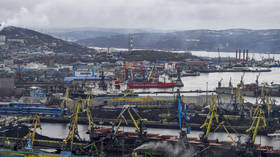The two countries have agreed on steps to diversify economic cooperation and deal with a trade imbalance
The share of national and alternative currencies in trade between Russia and India has reached almost 90%, Russian First Deputy Prime Minister Denis Manturov said in New Delhi on Tuesday. Over the past five years, bilateral trade between the two countries has grown more than fivefold, making India Moscow’s second largest trade partner, the minister added.
Manturov is visiting India to co-chair the 25th meeting of the Intergovernmental Russian-Indian Commission on Trade, Economic, Scientific, Technical, and Cultural Cooperation, along with Indian Foreign Minister S. Jaishankar.
Addressing the topic of cross-border payments, the Russian deputy prime minister emphasized that the issue is being closely monitored. Bilateral trade has been impacted since 2022, when Russia was hit by US-led sanctions, and many Russian banks were cut off from SWIFT, Visa, and MasterCard, prompting Russia and its major trading partners to use alternative mechanisms to settle trade.
“The share of national and alternative currencies in bilateral trade is growing – it has already reached 90%. We believe it is necessary to continue working on expanding correspondent relations between Russian and Indian banks,” Manturov said.
While lauding the constantly expanding trade and economic cooperation that “benefits from the trust and confidence built” over the years, both sides acknowledged that certain issues remain unresolved. This includes a large trade imbalance driven by India’s rapid increase in purchases of crude oil from Russia. While imports from Russia last year stood at $61.1 billion, Indian exports were just $4.2 billion.
“Our goal is to ensure that trade is more balanced, which will require addressing current constraints and undertaking facilitative efforts,” Jaishankar said on Tuesday. At the same time, he noted the importance of Russia as a reliable supplier of crude oil, coal, uranium, and fertilizers to India, ensuring its energy and food security. Manturov also emphasized the importance of diversifying trade.
Co-chaired a productive and wide ranging 25th meeting of the India-Russia Intergovernmental Commission in Delhi. Thank my co-chair First DPM Denis Manturov and our delegations for their contribution. Our deliberations covered the complimentary and beneficial 🇮🇳 🇷🇺 economic and… pic.twitter.com/J5W0deSzX2
— Dr. S. Jaishankar (@DrSJaishankar) November 12, 2024
“We have already increased agricultural exports to India, primarily sunflower and soybean oil. Russia, aside from purchasing products of the agro-industrial complex from India, also imports industrial equipment, components, pharmaceutical drugs, and substances,” the Russian minister said. He stated that Moscow is “strongly committed” to signing a trade pact between India and the Eurasian Economic Union (EAEU), as well as a bilateral agreement on protecting investments. “This fully meets the needs of our business community,” he noted.
Jaishankar stressed that efforts towards more balanced trade should include progress in the negotiations for the free trade pact between India and the EAEU, comprising Armenia, Belarus, Kazakhstan, Kyrgyzstan, and Russia. The idea of such a deal was initially proposed in 2013 and discussions were held in 2017, although no further progress was made. The talks for a free trade pact were restarted in March of this year.
Improving connectivity between the two countries was also named as one of the priorities. The majority of goods are transported between the two countries via the Suez Canal. However, given the disruption of global logistics and supply chains due to Western sanctions against Russia, Moscow and New Delhi have been actively developing alternative routes.
This includes the North-South Transportation Corridor (INSTC) – a 7,200km-long route connecting India to Russia and Europe, Central Asia, and Afghanistan via Iran – the Vladivostok-Chennai corridor that connects India’s southeastern coast with Russia’s Far East, and the Northern Sea Route (NSR) that passes along Russia’s northern coastline through the Arctic Ocean and is considered the shortest shipping route between the western part of Eurasia and the Asia-Pacific region.
You can share this story on social media:




